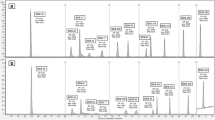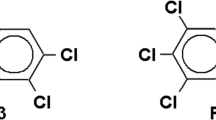Abstract
The exposure to bisphenols and their derivatives was assessed in 33 fish products sold in Turkey using high-performance liquid chromatography-tandem mass spectrometry (LC–MS/MS). BADGE was determined in only four samples at concentrations ranging between 0.06 and 0.22 mg/kg. As the most abundant bisphenol groups, BADGE-hydrolyzed products such as BADGE·H2O and BADGE·2H2O were present in nine and fourteen samples in the range between 0.06–0.16 and 0.06–0.72 mg/kg, respectively. The total concentration of BADGE and hydrolyzed products was below the specific migration limit (SML) value of 9 mg/kg food, which in the European Union stated as tolerable. Chlorinated derivatives of BADGE were detected in fewer samples compared with hydrolyzed ones. BADGE·H2O·HCl was the predominant migrant among chlorinated derivatives and was present in seven samples in a range between 0.02 and 0.06 mg/kg. All other samples contained less than or equal to 0.03 mg/kg of BADGE·HCl and BADGE·2HCl. The sum of these derivatives was lower than the SML value (1 mg/kg) of BADGE chlorohydrins legislated by the European Union. Besides these migrants, the analyzed samples did not contain any BFDGE and 3R-NOGE, which are prohibited in manufacturing food contact materials.

Similar content being viewed by others
Data availability
Not applicable.
Code availability
Not applicable.
References
Cabado AG, Aldea S, Porro C, Ojea G, Lago J, Sobrado C, Vieites JM (2008) Migration of BADGE (bisphenol A diglycidyl-ether) and BFDGE (bisphenol F diglycidyl-ether) in canned seafood. Food Chem Toxicol 46(5):1674–1680
[EC] European Commission. 2005 Commission Regulation (EC) No 1895/2005 of 18 November 2005 on the restriction of use of certain epoxy derivatives in materials and articles intended to come into contact with food J Eur Union L302 28 32
El-Kosasy AM, Ayad MF, Mabrouk OM (2018) Validated chemometrics-assisted spectrophotometric methods for simultaneous determination of bisphenol-A-diglycidyl ether and some of its reaction products in canned foods in the Egyptian market. Spectrochim Acta A 203:443–449
Fattore M, Russo G, Barbato F, Grumetto L, Albrizio S (2015) Monitoring of bisphenols in canned tuna from Italian markets. Food Chem Toxicol 83:68–75
Gallart-Ayala H, Moyano E, Galceran MT (2011) Fast liquid chromatography-tandem mass spectrometry for the analysis of bisphenol A-diglycidyl ether, bisphenol F-diglycidyl ether and their derivatives in canned food and beverages. J Chromatogr A 1218(12):1603–1610
Grob K, Camus P, Gontard N, Hoellinger H, Joly C, Macherey AC, Masset D, Nesslany F, Régnier JF, Riquet AM, Saillard P, Ribera D (2010) Need for a better safety evaluation of food contact materials produced from resins. Food Control 21(5):763–769
Guo M, He M, Zhong J, He Q, Ismail BB, Chen G, Liu D (2020) High-performance liquid chromatography (HPLC)-fluorescence method for determination of bisphenol A diglycidyl ether (BADGE) and its derivatives in canned foods. Sci Total Environ 710: 134975.
Hammarling L, Gustavsson H, Svensson K, Oskarsson A (2000) Migration of bisphenol-A diglycidyl ether (BADGE) and its reaction products in canned foods. Food Addit Contam 17(11):937–943
Hwang JB, Lee S, Lee JE, Choi JC, Park SJ, Kang Y (2020) LC-MS/MS analysis of BADGE, NOGEs, and their derivatives migrated from food and beverage metal cans. Food Addit Contam: Part A 37(11):1974–1984
Leepipatpiboon N, Sae-Khow O, Jayanta S (2005) Simultaneous determination of bisphenol-A-diglycidyl ether, bisphenol-F-diglycidyl ether, and their derivatives in oil-in-water and aqueous-based canned foods by high-performance liquid chromatography with fluorescence detection. J Chromatogr A 1073(1–2):331–339
Lapviboonsuk J, Leepipatpiboon N (2014) A simple method for the determination of bisphenol A diglycidyl ether and its derivatives in canned fish. Anal Methods 6(15):5666–5672
Marqueño A, Pérez-Albaladejo E, Flores C, Moyano E, Porte C (2019) Toxic effects of bisphenol A diglycidyl ether and derivatives in human placental cells. Environ Pollut 244:513–521
Míguez J, Herrero C, Quintás I, Rodríguez C, Gigosos PG, Mariz OC (2012) A LC-MS/MS method for the determination of BADGE-related and BFDGE-related compounds in canned fish food samples based on the formation of [M+ NH4]+ aducts. Food Chem 135(3):1310–1315
Noonan GO, Ackerman LK, Begley TH (2011) Concentration of bisphenol A in highly consumed canned foods on the US market. J Agr Food Chem 59(13):7178–7185
Petersen JH (2003) Migration of compounds from food contact materials and articles. In: D’Mello JPF (ed) Food Safety: Contaminants and Toxins. CABI Publishing, UK, pp 271–291
Rauter W, Dickinger G, Zihlarz R, Lintschinger J (1999) Determination of bisphenol A diglycidyl ether (BADGE) and its hydrolysis products in canned oily foods from the Austrian market. Z Lebensm Unters F A 208:208–211
Simoneau C, Theobald A, Wiltschko D, Anklam E (1999) Estimation of intake of bisphenol-A-diglycidyl-ether (BADGE) from canned fish consumption in Europe and migration survey. Food Addit Contam 16(11):457–463
Szczepańska N, Kudłak B, Namieśnik J (2018) Assessing ecotoxicity and the endocrine potential of selected phthalates, BADGE and BFDGE derivatives in relation to environmentally detectable levels. Sci Total Environ 610–611:854–866
Szczepańska N, Kubica P, Kudłak B, Namieśnik J, Wasik A (2019) Stabilities of bisphenol A diglycidyl ether, bisphenol F diglycidyl ether, and their derivatives under controlled conditions analyzed using liquid chromatography coupled with tandem mass spectrometry. Anal Bioanal Chem 411:6387–6398
Sueiro RA, Suárez S, Araujo M, Garrido MJ (2003) Mutagenic and genotoxic evaluation of bisphenol F diglycidyl ether (BFDGE) in prokaryotic and eukaryotic systems. Mutat Res-Gen Tox En 536(1–2):39–48
Summerfield W, Goodson A, Cooper I (1998) Survey of bisphenol a diglycidyl ether (BADGE) in canned foods. Food Addit Contam 15(7):818–830
Xie Y, Bao Y, Wang H, Cheng Y, Qian H, Yao W (2015) Release of bisphenols from can coatings into canned beer in China market. J Sci Food Agr 95(4):764–770
Yonekubo J, Hayakawa K, Sajiki J (2008) Concentrations of bisphenol A, bisphenol A diglycidyl ether, and their derivatives in canned foods in Japanese markets. J Agr Food Chem 56(6):2041–2047
Zhang H, Xue M, Lu Y, Dai Z, Wang H (2010) Microwave-assisted extraction for the simultaneous determination of novolac glycidyl ethers, bisphenol A diglycidyl ether, and its derivatives in canned food using HPLC with fluorescence detection. J Sep Sci 33:235–243
Funding
This work was supported by the Balikesir University Scientific Research Projects Unit for providing financial support for the research project 2020–042, entitled “Determination of Bisphenol A diglycidyl ether (BADGE) and its derivates in canned fish from the Turkish market.”
Author information
Authors and Affiliations
Contributions
İT: sample preparation and performing analyses. MK: contribution to the design of the work, preparation of the manuscript draft, and interpretation of data. OK: final manuscript check, manuscript formatting, manuscript submission, preparation of the figure, and formatting of the tables. MFR: final manuscript check, contribution to the design of the work, and improving text quality. All authors read and approved the final manuscript.
Corresponding author
Ethics declarations
Ethics approval
Not applicable.
Consent to participate
Not applicable.
Consent for publication
Not applicable.
Conflict of interest
The authors declare no competing interests.
Additional information
Responsible Editor: Philippe Garrigues
Publisher's note
Springer Nature remains neutral with regard to jurisdictional claims in published maps and institutional affiliations.
Supplementary Information
Below is the link to the electronic supplementary material.
Rights and permissions
About this article
Cite this article
Toptancı, İ., Kıralan, M., Ketenoglu, O. et al. Monitoring of bisphenol A diglycidyl ether (BADGE) and some derivatives in fish products in the Turkey market. Environ Sci Pollut Res 29, 52788–52795 (2022). https://doi.org/10.1007/s11356-022-19587-z
Received:
Accepted:
Published:
Issue Date:
DOI: https://doi.org/10.1007/s11356-022-19587-z




